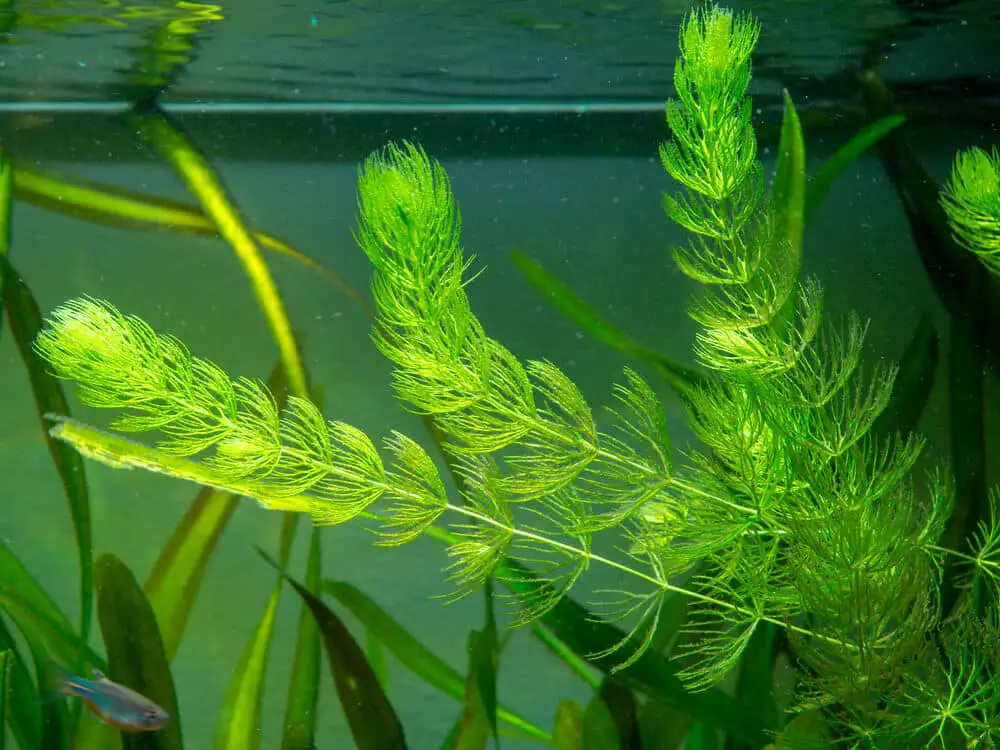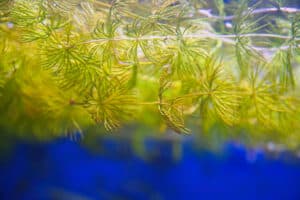Hornwort is one of the fastest-growing aquarium plants that is popular for its fast growth rate. Read on to explore how fast this plant can grow in a tank and what you can do if it outgrows your tank.
Here’s How Fast Hornwort Grows:
As a general rule, Hornwort grows around 1-6 inches every week. However, in some cases, when the tank is overstocked, and the plant has lots of nutrients available, it can even grow over an inch per day.
So after you plant Hornwort in the aquarium and look back in a few days, don’t be surprised to see them outgrowing the tank. They are indeed one of the fastest-growing plants in the aquarium hobby.

Hornwort is a stem plant that looks quite bushy. It is one of the easiest growing aquarium plants – you can grow it simply by tossing it in the tank. The plant will grow just fine whether you float or anchor it.
The plant is known to grow in the wild – as much as 10 feet tall! So the larger the tank, the better it is to ensure the plant fits wells in the tank.
Otherwise, the only hassle would be to trim the plant regularly to maintain it in the right shape.
Usually, a 10-15 gallon tank is a good start for keeping the hornwort plant.
What Causes Fast Growth Rate In Hornwort Plants?
Here are the key factors that cause faster growth in Hornwort:
- Availability of enough light
- Enough or excess nutrients in the water
- Perfect water parameters like temperature, pH, and hardness
Lighting: Hornwort generally requires a moderate level of lighting for proper growth. But more intensity of light results in a higher growth rate. So the more light is available, the bigger your Hornwort will grow.
Nutrients: Like any other aquarium plant, hornwort absorbs nutrients present in the tank ecosystem for growth. Hornworts are well-known for taking a lot of nutrients from the water, so the more excess nutrients are available, the faster the plant will grow.
Ideal Water Parameters: Finally, having ideal water parameters in the tank also promotes better growth of the plant. Hornworts need 59°F to 86°F temperature, 6 to 7.5 pH level, and water hardness of 5-15 dGH.
Hornwort is a hardy plant that can grow well in a wide spectrum of temperatures and conditions. That said, when the ideal conditions are available, you can expect them to grow rapidly.
What To Do If Hornwort Outgrows The Tank?
If you want to let hornworts grow slower, the short answer is to reduce the ideal conditions. For instance, you can limit the plant’s light availability, which can decrease its normal, fast growth rate.
Usually, when enough light is not present in the tank, the plant will grow slowly.
But beware of limiting the light too much. Otherwise, you could be hampering the plant.
The idea is to reduce the plant’s growth rate without having a major impact on the plant. So start implementing any steps slowly and see how the plant reacts to the changes.
The best way to keep the hornworts in control is to prune them regularly whenever needed. For example, if Hornwort outgrows the tank, trim the necessary portions of the plant.
Before explaining more about the trimming process, let’s first get a brief overview of its parts and appearance.
The hornwort plant doesn’t have true roots. Instead, a single hornwort plant will have a couple of stems, giving it the appearance that there are many plants and not just one growing plant.
Hornwort has needle-like leaves. Usually, the plant looks bushy overall. But when it grows rapidly, expect it to lose its bushy appearance.
The base leaves of the plant and rhizoids play the key role of anchoring the plant to a particular substrate.
The leaves of the hornwort plant are formed in the form of whorls (6-12 in number). The leaves are present as a small outgrowth from the stem up to the top part of the plant.
Now here’s the interesting part, Hornwort doesn’t have any roots. So no matter how you trim or cut the plant from any part, it will tend to grow. Hence, there’s no hard and fast rule regarding how you should trim the hornwort plant.
For trimming and pruning, you can use the typical aquarium plant trimming tools.
Or else you can also pinch the plant if you don’t prefer using any aquascaping tools.
As long as you have trimmed the hornwort plant from a part of its stem, the plant will set a new outgrowth from the trimmed portion.
- If you want to make the hornwort plant grow into many strands, it is a good idea to trim the tips of the plant from where it generally grows.
- Another way to trim the hornwort plant is to find the strands that grow too big. Then take them out, trim the bottom portion of that strand and replant it from the top. This way, the plant will always remain at the size you wish.
Will Hornwort Affect The Growth Of Other Plants In The Tank?
Unfortunately, Hornwort possesses allelopathic abilities, which means Hornwort will inhibit the growth of other aquatic plants because of the chemicals it produces.
Allelopathy in any plant is its ability to stop the growth of its surrounding plants by releasing chemicals.
Hornwort exhibits this type of behavior as a part of its survival mechanism. It slows the growth of surrounding plants in their habitat so that they can have access to more resources and space to thrive well.
So if you plant hornworts in your tank, you either need to add fertilizers or carbon dioxide from outside to support the growth of other plants in the tank. Otherwise, have the hornworts as the only single plant type in the tank.
Final Thoughts
Once in a while, as you notice Hornwort has taken over the tank, trim it or pinch its growing tips. This way, you can keep the plant in perfect shape.
The plant can seem demanding in terms of pruning and managing its growth rate. But it also comes with many benefits, like adding a beautiful and natural look to the tank, helping in oxygenation, and absorbing waste and excess nutrients.
Hi! I’m Praveen Ghoshal, the founder of eFishkeeping.com. Inspired by my Dad, I got interested in fishkeeping when I was a kid. Since then, I have been involved with this hobby. Currently, I have 3 fish tanks at our home, and I enjoy this hobby with my full family. Read more about me here.


![Why Are Anubias So Expensive? [Reasons + Cheap Alternatives] why-are-anubias-so-expensive](https://efishkeeping.com/wp-content/uploads/2022/12/anubias-in-a-planted-aquarium-300x200.jpg)




